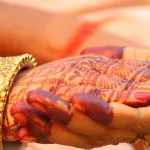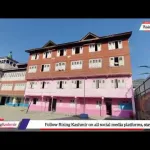CULTURE
Albain (plough) was an indispensable tool of agriculture. It played a crucial role in agricultural activities of Kashmir. It made the hard task of peasants easy. Called Hal in Hindi, it was used to tilt land to be prepared for sowing seeds or harvesting of crops. It has now been replaced by tractors. However, there are certain places in Kashmir, where the culture of ploughing the land with the traditional Albain is still intact. Albain was pulled by two oxen.
As for the graphic description of Albain, it consisted of Kurheit (a bow shaped sole) with its front tip an iron Phaal (ploughshare) with two Wangin (pronged nile). A socket was made on the back portion of the sole in which two wooden logs were fitted in. One log was called Laratha (handle) which was straight with a grip for the user and another was Lanz (pole) which was a curved log, long up to the head of the oxen while in traction. On the shoulders of the oxen were kept Yepatte (a yoke) which was a board of wood. In the middle of the yoke, a peg of wood was fixed called Ahkij. Then Lanz (pole), Yepatte (yoke) and Ahkij (a peg) were tied with a Mitlier (a leather loop). Then four wooden pegs, two on each side of the yoke were put in the yoke holes so that the shoulders of the oxen were adjusted. These were called Hamchoor. After that two ropes tied to the pegs are adjusted round the neck of the oxen so that plough is adjusted to the oxen.
Usually, there were four types of ploughs used for tilting of land in Kashmir. All had difference in structure and were used on different soils in different parts of Kashmir. Two were known as Albain, third was called Batij and the fourth was called Heej. Albain was common through the Valley; however Batij was used in certain parts of south Kashmir and Heej in the damp land. All these plough types varied in their shapes and structures were used on different soils in different parts of Kashmir.
Batij plough in Kashmir was altogether different from other ploughs in size, look, weight and structure and was used in certain areas of south Kashmir where as Heej was used for ploughing the wet land. Its sole had no iron ploughshare. It was same in shape and structure as Albain. Harrow (majj) called Matil locally was similar to Albain except its square beamed base which was used to break up clods and level the furrows in the wet paddy fields.
Albain is believed to have originated from somewhere between Egypt and Persia and has been accordingly used in Europe, north & east America. There are some evidences that tell us that Albain was shown in Egyptian paintings before 3000 BC. It is interesting to know that in many of the older civilizations the origin of Albain is attributed to a god of some legendary character. According to a Chinese myth Shen Nung, the heavenly husbandman was a sage who lived in the third millennium BC and taught his people the use of Albain in the fields. In India, Albain is ascribed to Balarama (called haldhar) who in one of the verses of Nilamata Purana, is said to have broken forth Himalayas with plough. It is also believed that Albain was developed as a result of the adaptation of a digging-stick or of a hoe. There is all probability that Albain would have passed through the various stage of evolution.
An interesting point is that it is said that Albain must have been made by priests for it was anciently said that it was the gift of gods to men to increase production of their crops in the fields. Kashmiri ploughs resembled with those of Persia and Central Asia. The Albain and Gajemeh were same, only adjustment of yoke differed. At the same time Batij and Munna, Albain and Hal also resemble with each other. However, one thing is clear that the invention of it was a major landmark in the history of agriculture. It rather heralded an agricultural revolution. With it, more and more land came under cultivation instead of having remained barren. Because of this leading tool in the agricultural operations in Kashmir since remote past, production multiplied to tackle the need of the growing population.
The woods used for making Albain were put in water then made bone dry so that after turning it into required tool the wood do not shrink. It was a general practice to use the wood procured previously a year ago. Fresh wood was avoided for making it. Different parts of it were made out of different plant types. For example, the sole was made of tul (mulberry wood), the handle of kiker (acacia), the yoke of brimji (celtis australis), the pole of poshu (yew) or cheeru (apricot), and the pegs of kiker wood. The strength of the stuff and the exertion at the time of use were main reasons for selecting different woods.
The Albain was manufactured locally by Chhan (carpenter) and some work was later done by Khaar (iron smith) who were an important component of village social life. These artisans, present in all localities, were paid Dhaan (rice) in lieu of their services at the time of harvesting. In my locality the most durable Albain was believed to have been made from deodar (cedrus deodara) wood brought from the nearby forest because users believed deodar to have more than hundred years of age. While the implement was not used during off season, every care was taken for its safety. It was avoided to keep it in the open because the continuous sunshine and rains destroyed the material and shorten its life span.
Albain has found a mention in Kashmiri folklore and poetry as well. It was in the signature tone of Dehati programme been aired by Radio Kashmir Srinagar. I remember it was: Arzath Chein Rooz Asse Poshani, Maermanz Sani Albaine. (We remember your many many favors. Oh! Our beautiful plough). In Son’th (spring season) when Gungo’ul was observed in my vicinity, we as children would burst would laughter when we would see some peasants enjoying the ride by lifting themselves on the harrow base to break the clods and level the mud. Besides this, Patdah (clod crasher) was also used by farmers in their dry land to crash clods and level the ground. It was a log of wood attached to a draught pole and drawn over the furrows by bullocks.
It is important to mention here that for safety of bullocks, ploughman had always a knife in his pocket to cut the noose tightened around their neck when sometimes bullocks fought with each other by some reason. On such emergencies, the tool proved quite useful. In both the Khushk (dry land) and Aebi (wet land), the first plough was locally called Voobi and the second round was called Allae.
The legacy of Albain lives on in the architectural wonders and artistic heritage of Kashmir. As a testament to their importance, we need to preserve this artifact of culture and heritage and save it before it will completely vanishes and we only presume how it looked like.
(The Author is Rafiabad based RK Columnist, teacher and freelancer. He is also a recipient of National Peace Award)





